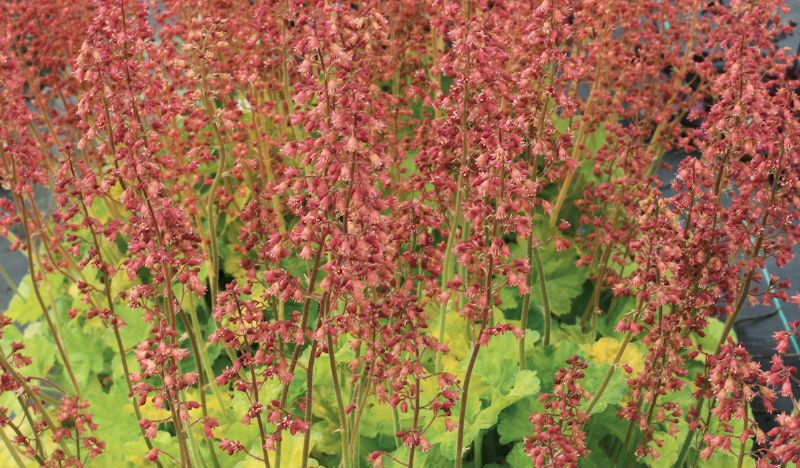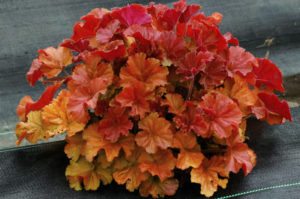
Culture Report: Heuchera Northern Exposure Series
For a company whose name is synonymous with heuchera, it can become a challenge to introduce something new under the sun. By listening to our customers, we heard a clear demand for much hardier landscape material, even capable of surviving harsh Zone 3 winters.
In the early 1980s, Collicutt and Marshall had a breeding program at the Morden Research station in Manitoba, Canada. These breeders saw the potential of a little-known Canadian heuchera, Heuchera richardsonii, a native to the Canadian plains which tolerated temperatures down to 40° F. While the Canadian breeders were able to improve the flowers on an otherwise drab plant, they did not have access to the diverse genetics of Terra Nova. Janet Egger, Terra Nova’s heuchera breeder noted the rounded, Pelargonium hortorum-like foliage of the species, and was able to preserve this feature and its naturally great crown count while introducing new leaf colors, showier flowers and shorter inflorescences.
Out of this work came the Northern Exposure collection, featuring plants with medium-large mounding habits. The collection features an exceptional range of rich-colored foliage with attractive, short flower stalks and great hardiness. Our breeder was thrilled to discover an innate rust resistance — no rust has been found on this crop in five years of growing them in the Pacific Northwest, an environment where rust abounds. These new varieties are ideal for single or group plantings in the landscape or planters, providing long-lasting foliage color to brighten up the greyest days of fall and winter.

Propagation
Plants of heuchera Northern Exposure are available as liners from tissue culture. Maintain an optimal root zone temperature of 65 to 70° F. Then begin feeding at 75- to 150- ppm nitrogen maintaining an EC between 0.6 and 0.9. We recommend using a low-phosphorus, calcium nitrate-based fertilizer to provide adequate nutrients without promoting the soft, stretchy growth seen under an ammonia-based fertilizer programs.
Finishing
Use a well-drained soil mix with a pH of 5.8 to 6.5. Care must be taken not to bury the crown as it is the number one cause of failure. Directly after transplanting, slightly warmer temperatures will promote rapid growth and root development. After 10 to 18 days, optimal growing temperatures are 65 to 75° F days and 57 to 62° F nights. Plant quality is enhanced by finishing plants with cooler night temperatures of 52 to 57° F and partial shade.
Scheduling Media and Fertilization
Allow the soil to dry out between waterings to promote healthy root development. Overly moist soil conditions may create favorable environments for fungal and bacterial pathogens to colonize. Drier conditions will also help reduce petiole and internode stretch. Soils with excellent drainage and lower peat content are recommended. Fertilize at 75- to 150- ppm nitrogen using a balanced feed to maintain foliage color.
Fertilizers containing a low percentage of ammonium and urea are recommended to reduce internode and petiole stretch. Irrigate occasionally with clear water to help eliminate salt build- up. An optimal EC for finishing is 0.6 to 0.9.
Pinching and Growth Regulators
Pinching is not necessary. The Northern Exposure series has high crown counts, making PGR applications unnecessary.

Insects and Diseases
Fungus gnats are the most prevalent pests, particularly during propagation. Pythium, Phytophthora and Rhizoctonia are the primary root/soil disease concerns. Allowing soil to dry out between waterings and avoiding sending plants into their night cycle with water on the foliage will tremendously reduce disease and pest pressure. Botrytis can occur with ideal conditions of high humidity and cool temperatures. Scouting for any issues along with a preventative drench and spray program should help prevent most pest infestations and diseases.
Available Colors
‘Northern Exposure Amber’. Luscious rounded leaves of glowing amber tones support yellow and green flower stems to 18 inches tall. It tolerates all light exposures and is extremely cold and rust resistant and long-lived.
‘Northern Exposure Lime’. This medium-large, long-lived landscape plant with multiple crowns and round, lime green leaves stays lime green all year. It forms a dense, rounded mound and has narrow 24-inch spikes of rust-red and green flowers.
‘Northern Exposure Red’. This heuchera has clean lines for the landscape with clear, dark red to burgundy, round leaves on a dense, medium size mound. This showy garden plant looks good longer in the season than other heuchera. The 18-inch spikes of yellow-green flowers contrast nicely with the red foliage. It features great rust resistance and longevity.



 Video Library
Video Library 




















